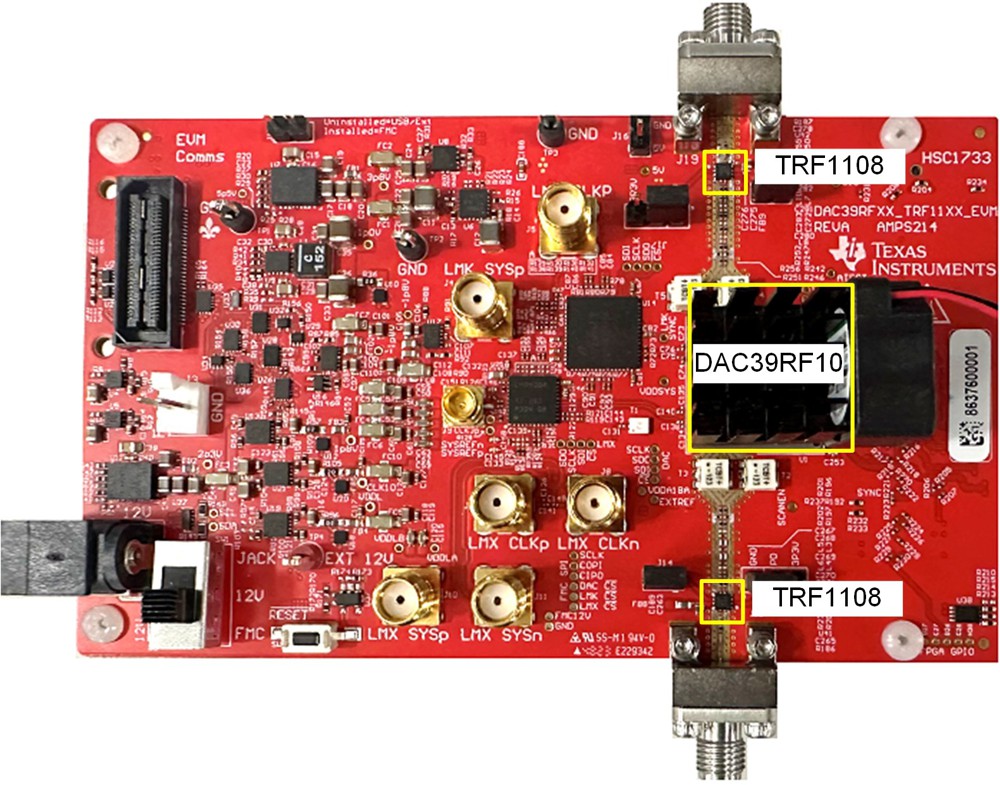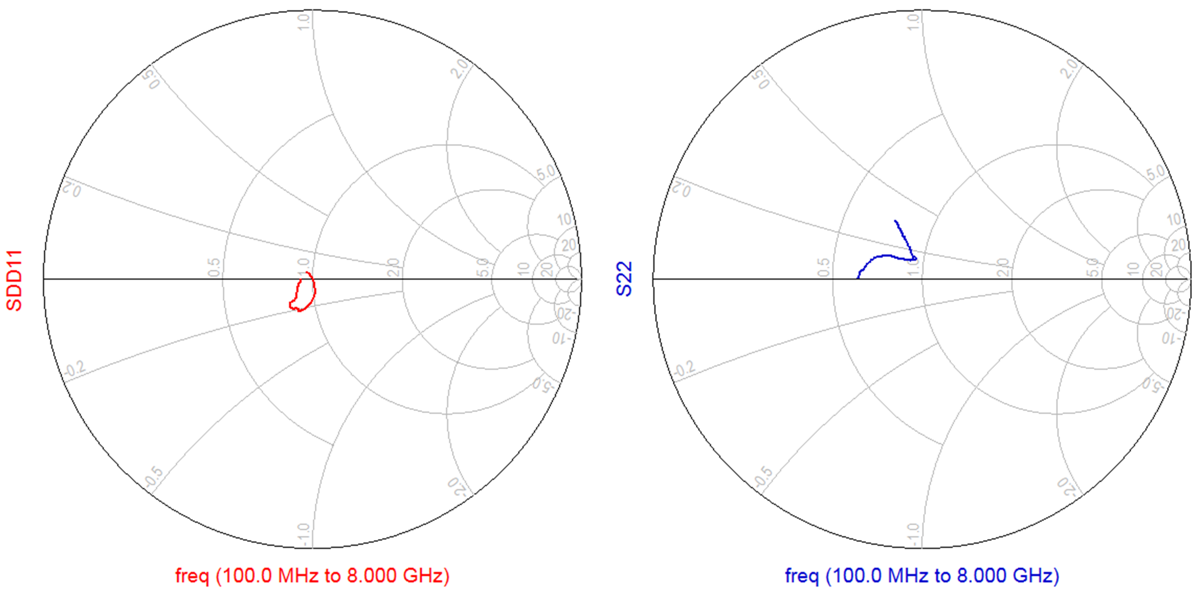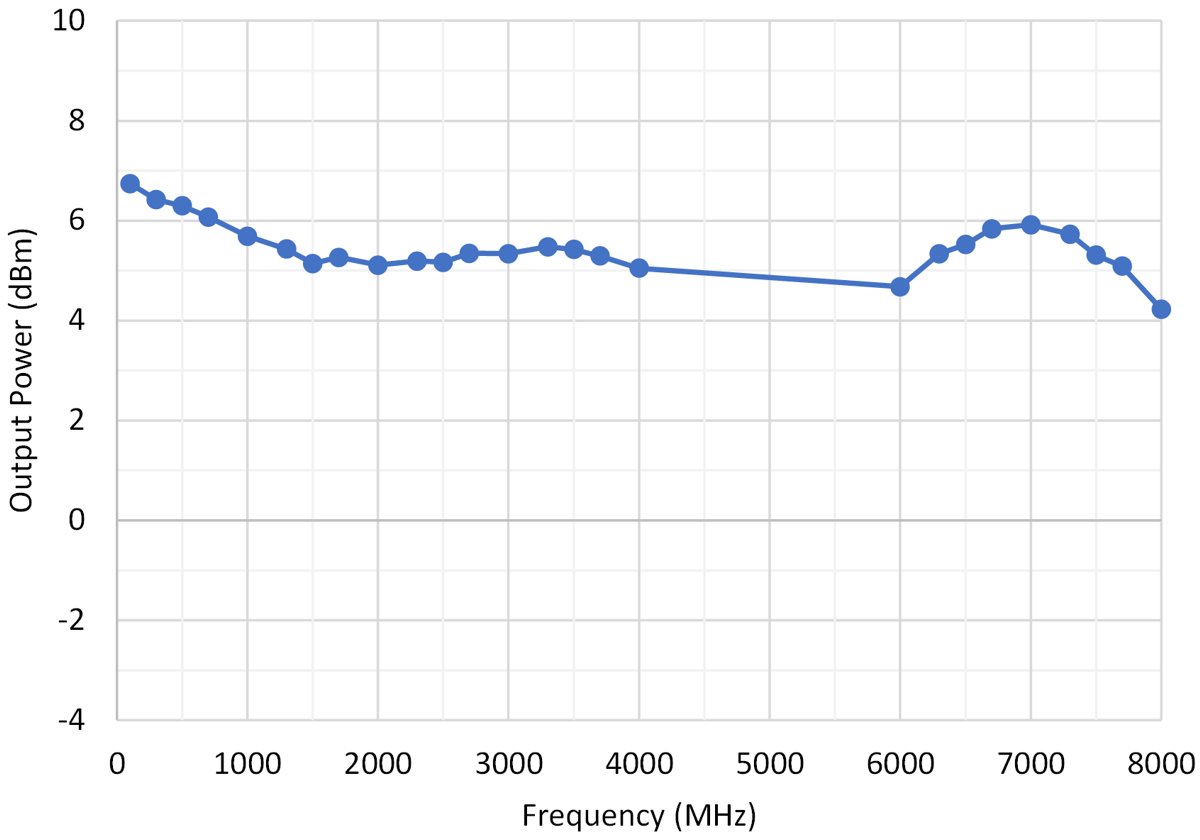SSZTD52 August 2024 TRF1108
Traditional radio-frequency (RF) transmit signal chains typically use digital-to-analog converters (DACs) to produce a baseband signal. This signal is then upconverted to the desired RF frequencies using an RF mixer and a local oscillator. Advancements in RF DAC technology now allow the signal to be generated directly at the desired RF frequency, significantly simplifying the design and complexity of RF transmit signal chains.
High-frequency RF DACs have balanced differential outputs, while the RF transmit chain and antenna are single-ended. Historically, RF engineers have used two devices, a passive balun and an intermediate stage RF gain block, to perform the differential to single-ended (D2S) conversion and increase the power of the RF signal. However, passive baluns have several limitations, including a large printed circuit board (PCB) footprint, high insertion loss, poor match, gain, and phase imbalance when needed to operate across wide bandwidths. RF passive balun also cannot support operation at or near DC.
A D2S RF amplifier is a monolithic device capable of converting differential signals to single-ended signals and providing gain across a wide bandwidth. This article outlines the advantages of using a D2S RF amplifier over a traditional passive balun and RF gain block approach.
Figure 1 shows the TRF1108 D2S RF amplifier used as a DAC buffer and a power amplifier (PA) pre-driver.
 Figure 1 Simplified RF transmitter signal
chain showing the TRF1108 differential to single-ended RF amplifier used as a DAC
buffer and PA pre-driver
Figure 1 Simplified RF transmitter signal
chain showing the TRF1108 differential to single-ended RF amplifier used as a DAC
buffer and PA pre-driverDifferential to single-ended conversion and gain in 4mm2
Passive baluns that perform D2S conversion at the RF DAC output are often bulky and expensive, particularly when they need to be wideband. The large footprint of the passive balun increases the PCB area and results in long PCB traces that limit RF performance, especially when used with multi-channel RF DACs. Further, wideband passive baluns also have high insertion losses, requiring a high-performance RF gain block to compensate for the loss of signal power.
The TRF1108 D2S RF amplifier is a monolithic device that performs D2S conversion and provides gain. With bandwidths covering DC to 12GHz, the D2S RF amplifier can be used for wideband DAC buffer applications from DC to multiple gigahertz. The TRF1108 has a tiny PCB footprint of only 2mm by 2mm, reducing the PCB area, resulting in shorter routing and improved RF performance.
Figure 2 shows the 2mm-by-2mm PCB footprint of the TRF1108, reducing the needed PCB area, resulting in shorter routing and improved RF performance on the TRF1108 DAC39RF10 evaluation module.
 Figure 2 TRF1108 DAC39RF10 evaluation
module (TRF1108-DAC39RFEVM)
Figure 2 TRF1108 DAC39RF10 evaluation
module (TRF1108-DAC39RFEVM)High density use-case example
Radar system designers choose the operating frequency based on the desired range, resolution, and antenna size. An RF DAC with wide bandwidth coverage, combined with a D2S RF amplifier, allows for hardware design reuse for different frequency-band applications with minimal changes to the RF transmit signal chain.
Combining an RF DAC and D2S RF amplifiers enables numerous advantages for high-density phased-array radar applications with digital beamforming. In these applications, multiple DAC outputs connect to numerous antennas, each transmitting a phase-shifted RF signal relative to each other. Multi-channel RF sampling DACs and transceivers integrate multiple DACs within a single die and package. This integration helps simplify system design and reduces hardware size and complexity. However, a small and high-performance D2S RF amplifier is required to efficiently utilize the highest possible density these multi-channel RF DACs enable.
Matched input and output
Wideband passive baluns traditionally used with RF DACs have difficulty maintaining good input and output return loss, and the return losses are also sensitive to input and output termination impedances. This sensitivity results in varying impedance across the RF bands of interest, creating unwanted gain variations of the transmitted signal. The differential inputs of the TRF1108 are impedance-matched to 100Ω. The single-ended output of the TRF1108 is broadband matched to 50Ω, improving return loss and resulting in a very flat passband response over a wide RF bandwidth (see Figure 3).
Figure 4 highlights how the matched input and output of the TRF1108 result in a flat passband response from 100MHz to 8GHz when combined with an RF DAC.
 Figure 3 Input and output S-parameters
of TRF1108 on a Smith chart
Figure 3 Input and output S-parameters
of TRF1108 on a Smith chart Figure 4 TRF1108 DAC39RF10 frequency
response from 100MHz to 8GHz
Figure 4 TRF1108 DAC39RF10 frequency
response from 100MHz to 8GHzOptimized for performance
Wideband passive RF baluns have high insertion losses that reduce the maximum signal power level from RF DACs. A single-ended high-performance RF gain block is needed to follow the passive balun to compensate for its insertion losses and increase the power level of the RF signal. Single-ended RF gain blocks typically have poor second-order nonlinearity performance, and the resulting distortion cannot be filtered out when the signal bandwidth covers multiple octaves. Furthermore, the poor gain and phase imbalance of wideband balun also leads to further imbalances, degrading the second-order nonlinearity of the RF signal.
D2S RF amplifiers such as the TRF1108 incorporate feedback techniques that help achieve improved gain and phase imbalance performance. The differential nature of the inputs results in improved second-order distortion compared to single-ended RF gain blocks. The TRF1108 D2S RF amplifier provides improved second-order nonlinearity for multi-octave RF transmit applications.
Conclusion
Technological advancements in RF DACs have enabled flexible, wideband RF applications in radars, software-defined radios, and RF test and measurement equipment. Integrating multiple RF DACs in multi-channel DACs and RF sampling transceivers has simplified transmit signal chain design and reduced the need for large PCB areas in multi-transmit RF and phased-array applications.
D2S RF amplifiers, like the TRF1108, offer RF signal bandwidths from DC to 12GHz. They complement the wide RF bandwidth and performance of RF DACs. The TRF1108, single-chip D2S RF amplifier, improves on the classic passive balun and RF gain block. It offers a smaller PCB area, reduced RF routing lengths, better matching, and enhanced performance. This results in higher density, better performance, and flexible RF transmit designs.
Additional resources
- For more technical information about D2S RF amplifiers, check out the application note, “TRF1208, TRF1108 Active Balun Interface With Xilinx RFSoC Data Converters.”
- Read our Analog Design Journal article “The impact of a balun on the second harmonic of an RF DAC.”
- Order the TRF1108EVM on TI.com and get started today.
- Check out TI’s RF and microwave products.
Trademarks
All trademarks are the property of their respective owners.